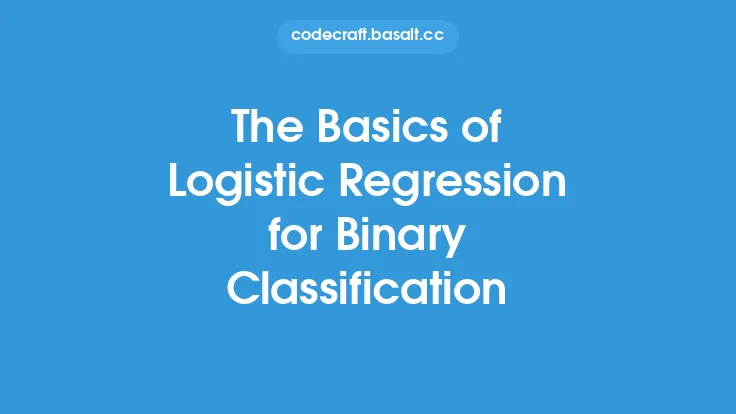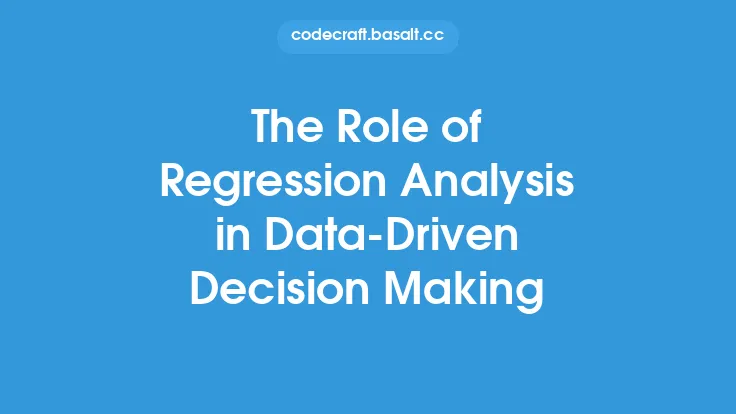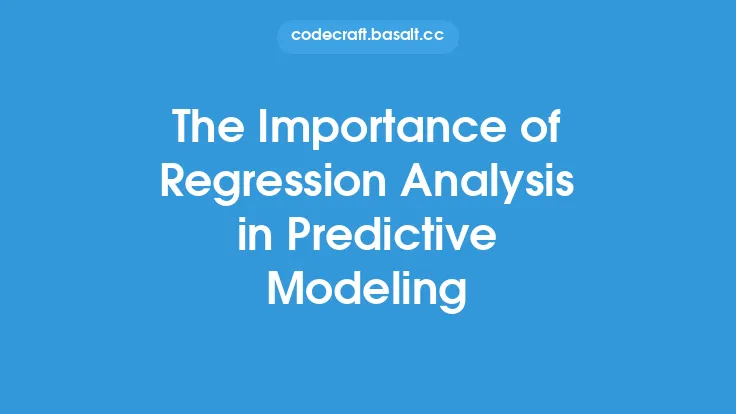Logistic regression is a fundamental concept in machine learning, particularly in the realm of regression analysis. It is a widely used algorithm for binary classification problems, where the goal is to predict one of two possible outcomes. In this article, we will delve into the fundamentals of logistic regression, exploring its underlying mathematics, applications, and interpretations.
Introduction to Logistic Regression
Logistic regression is a type of regression analysis used for predicting the outcome of a categorical dependent variable based on one or more predictor variables. The term "logistic" refers to the logistic function, also known as the sigmoid function, which is used to model the probability of the dependent variable taking on a particular value. In the context of binary classification, logistic regression is used to predict the probability of an event occurring, such as 0 or 1, yes or no, or positive or negative.
The Logistic Function
The logistic function, also known as the sigmoid function, is a mathematical function that maps any real-valued number to a value between 0 and 1. The logistic function is defined as:
σ(x) = 1 / (1 + e^(-x))
where e is the base of the natural logarithm and x is the input to the function. The logistic function has an S-shaped curve, where the output starts at 0, increases rapidly, and then levels off at 1. This curve is ideal for modeling binary outcomes, as it provides a smooth and continuous transition between the two possible values.
The Logistic Regression Model
The logistic regression model is a linear model that uses the logistic function to predict the probability of the dependent variable taking on a particular value. The model is defined as:
p = 1 / (1 + e^(-z))
where p is the probability of the dependent variable taking on a value of 1, and z is a linear combination of the predictor variables. The linear combination is defined as:
z = β0 + β1x1 + β2x2 + … + βnxn
where β0 is the intercept, β1, β2, …, βn are the coefficients of the predictor variables, and x1, x2, …, xn are the predictor variables.
Estimating the Model Parameters
The model parameters, β0, β1, β2, …, βn, are estimated using maximum likelihood estimation (MLE). MLE is a statistical method that finds the values of the model parameters that maximize the likelihood of observing the data. The likelihood function is defined as:
L(β) = ∏[p^y \* (1-p)^(1-y)]
where y is the observed value of the dependent variable, and p is the predicted probability. The log-likelihood function is defined as:
l(β) = ∑[y \* log(p) + (1-y) \* log(1-p)]
The model parameters are estimated by finding the values that maximize the log-likelihood function.
Interpreting the Results
The results of a logistic regression analysis can be interpreted in several ways. The coefficients of the predictor variables, β1, β2, …, βn, represent the change in the log-odds of the dependent variable taking on a value of 1 for a one-unit change in the predictor variable, while holding all other predictor variables constant. The odds ratio, which is the exponential of the coefficient, represents the change in the odds of the dependent variable taking on a value of 1 for a one-unit change in the predictor variable.
Applications of Logistic Regression
Logistic regression has a wide range of applications in machine learning and data analysis. Some common applications include:
- Credit risk assessment: Logistic regression is used to predict the probability of a customer defaulting on a loan based on their credit history and other factors.
- Medical diagnosis: Logistic regression is used to predict the probability of a patient having a particular disease based on their symptoms and medical history.
- Marketing: Logistic regression is used to predict the probability of a customer responding to a marketing campaign based on their demographic characteristics and behavior.
Advantages and Limitations
Logistic regression has several advantages, including:
- Easy to implement and interpret
- Can handle categorical and continuous predictor variables
- Can handle non-linear relationships between the predictor variables and the dependent variable
However, logistic regression also has some limitations, including:
- Assumes a linear relationship between the log-odds of the dependent variable and the predictor variables
- Can be sensitive to outliers and non-normality of the predictor variables
- Can be computationally expensive for large datasets
Conclusion
Logistic regression is a powerful and widely used algorithm for binary classification problems. It provides a smooth and continuous transition between the two possible outcomes and can handle categorical and continuous predictor variables. The results of a logistic regression analysis can be interpreted in several ways, including the coefficients of the predictor variables and the odds ratio. While logistic regression has several advantages, it also has some limitations, including the assumption of a linear relationship between the log-odds of the dependent variable and the predictor variables. Overall, logistic regression is a fundamental concept in machine learning and regression analysis, and its applications continue to grow in various fields.





